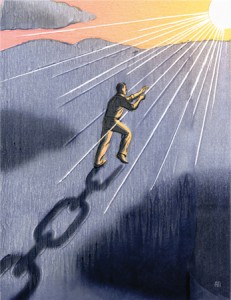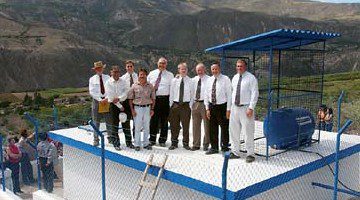Breaking free of worldly influences, the disciple strives for the embrace of a heavenly home.
 Breaking free of worldly influences, the disciple strives for the embrace of a heavenly home.
Breaking free of worldly influences, the disciple strives for the embrace of a heavenly home.
A few years ago our teenage daughter was feeling quite unsettled, asking some very honest questions, such as “Why is life so hard?”
As we talked over dinner one night, I prayed like a missionary for the right things to say. After all, our children are our most important investigators. In the very moment, I received a prompting about “gravitational pull.” I grabbed a paper napkin and drew a sketch I’d never thought of before. It sparked a lively discussion. I felt so close to her that night. She is the child of our covenant, and I want to be with her always. I’d like to share the ideas from that sketch on the napkin. I call this sketch “a disciple’s journey.”
A Disciple’s Journey
A disciple moves from darkness into light, which increases from the dim light of the stars to the moon and then to the brightness of the sun. Joseph Smith compared these heavenly bodies with the telestial, terrestrial, and celestial kingdoms. As the temple teaches, we can and should move toward that celestial light during mortality. We need not be of the world, even if we must live in the world.
Imagine two vertical lines separate the stars, moon, and sun into three sections. Each line suggests a major transition as we move from one stage to the next. However, our journey is not rigidly sequential. Our experiences may move us back and forth.
Envision also two circles, each with a center point, located in stage one and in stage three. These circles represent the gravitational pull from the opposing poles of our journey. In the darkness of stage one, he who claims to be the god of this world exerts a constant force to hold us back from moving toward the light. As we cross the first barrier, we leave the strongest satanic tugging—though he will always try to ensnare us wherever we are in the journey.
Reaching out from the center of light in stage three, Jesus “entices” us with a spiritual gravitational pull toward Him. Think of the father of the prodigal son, praying his son home. When the father saw his son coming from afar, the father “had compassion, and ran” to the boy “and fell on his neck, and kissed him” (Luke 15:20).
I compare that father to Christ, who is so eager for our return that He comes to meet and strengthen us all along our way. Nephi wrote, “It is by grace that we are saved, after all we can do” (2 Ne. 25:23). Christ’s running to us is a vivid symbol of that grace. We talk often in the Church about coming to Christ. Perhaps we should talk more about how Christ also comes to us. No matter where we are on that path, we are never lost to Him. We often sing, “Who’s on the Lord’s side? Who?”1 Let us also sing, “Be still, my soul: The Lord is on thy side.”2 We never have more value in the Lord’s sight than when we are feeling completely worthless.
Various terms describe this process. Mormon called a disciple a “true follower” of Christ (see Moro. 7:48)—one who follows the Son to return to the Father. Moroni said, “Come unto Christ, and be perfected in him” (Moro. 10:32). Jesus asked, “What manner of men ought ye to be? . . . Even as I am” (3 Ne. 27:27). Our Primary children sing, “I’m trying to be like Jesus.”3
Whatever we call it, this journey is the gospel’s central concern.
Some non-LDS observers of our Church think we haven’t made this concept very clear. One said that while Mormons emphasize “Christ’s dying for humanity,” they don’t go on and “link the atonement to that part of the [LDS] ‘plan of salvation’ that involves progression toward godhood.”4 In other words, she thinks we haven’t explained what the Atonement has to do with becoming like Jesus.
Another prominent observer recently chided us for not explaining in a public way what he called our “doctrine of the perfectibility of mankind into divine form.”5 In fact, however, the Restoration answers these questions with stunning clarity.
Initiation
As an act of will, we must take the step that initiates our journey. Some people take that initiative through their desire to find and follow God. Think of Nephi, a believer who wanted to see what his father saw (see 1 Ne. 11:1, 3). Think of Abraham, who desired “to be a greater follower of righteousness” (Abr. 1:2).
Some who live worldly ways decide they’ve had enough of Satan’s darkness, like the prodigal son, who “came to himself” and headed for home (Luke 15:17–18). Some, like Enos or young Alma, start moving when they remember their parents’ teachings. Many others initiate their journey when they accept a missionary’s invitation to “come and see” (John 1:39).
Often the Lord gives us a nudge by “calling” us, perhaps to serve a mission, inviting us to become what Mormon called “a disciple of Jesus Christ” who is “called of him to declare his word among his people” (3 Ne. 5:13). Mormon referred to his own Church calling as a “gift” (Moro. 7:2), probably because he discovered that his calling gave him experiences that let him truly come to know Christ. However we get started, the choice to begin this journey is an act of will. God Himself cannot and would not force us to take that step.
Opposition
As soon as you start moving toward the light, the gravitational pull of darkness will immediately try to jerk you back, “for Satan desireth to have you” (3 Ne. 18:18). He will tempt, frighten, and fight you. Missionaries know all about this. In some way, opposition hits virtually every investigator. The first time Adam and Eve taught their children the gospel, for example, Satan came among them, saying, “Don’t believe your parents.” And so the children “believed [them] not, and they loved Satan more than God. And men began from that time forth to be carnal, sensual, and devilish” (Moses 5:13).
Satanic opposition has great power in today’s world. Satan holds “a great chain in his hand” (Moses 7:26), which symbolizes such addictions as drugs, alcohol, and pornography—and the prince of darkness laughs at the poor souls he captures.
 But that opposition need not destroy us. Remember Joseph praying in the grove: an enemy power, he said, bound his tongue so he “could not speak” (JS–H 1:15). Remember Moses when he first saw his grand vision: “Satan came tempting him” until Moses feared exceedingly, and “he saw the bitterness of hell” (Moses 1:12, 20). But both Joseph and Moses called upon God, who gave them power to drive Satan away. That is a key insight: Satan may rattle us, but he cannot overcome us, for God can cast him from our presence.
But that opposition need not destroy us. Remember Joseph praying in the grove: an enemy power, he said, bound his tongue so he “could not speak” (JS–H 1:15). Remember Moses when he first saw his grand vision: “Satan came tempting him” until Moses feared exceedingly, and “he saw the bitterness of hell” (Moses 1:12, 20). But both Joseph and Moses called upon God, who gave them power to drive Satan away. That is a key insight: Satan may rattle us, but he cannot overcome us, for God can cast him from our presence.
Lehi said, “It must needs be, that there is an opposition in all things” (2 Ne. 2:11). So wherever you are on your journey, there will always be a reason not to go on. Don’t wait until all obstacles disappear. The purely rational mind will always find a good reason to hold back, for Satan places those obstacles in our path. But opposition can strengthen us. The skills of human growth are best “learned slowly against difficulty.”6¶
First Sacrifice
When an investigator breaks free from the worldly pull enough to repent and make serious covenants with God, he or she is ready for baptism—the clearest symbol of the first barrier of sacrifice. This sacrifice requires, at a minimum, giving up the most obvious sins. As King Lamoni’s father said, “I will give away all my sins to know thee” (Alma 22:18). By giving up short-term pleasures, he could find far more lasting satisfactions.
This sacrifice asks us to live the most basic temporal commandments, like tithing and the Word of Wisdom—which is “adapted to the capacity of the . . . weakest of [those who] can be called saints” (D&C 89:3). Often these are physical temptations. In the Judean wilderness, Satan first taunted the hungering Christ to make bread and eat (see Matt. 4:3).
For Church members who want to become serious disciples, the sacrament represents this first level of sacrifice. They commit not only to give away their sins but also to remember Christ and to follow Him until they know Him.
These early sacrifices fix one’s feet on a disciple’s path. For example, when Elder Neal A. Maxwell was an 18-year-old infantryman fighting on the island of Okinawa, he faced the most frightening night of his life. As enemy mortar shells began exploding ever closer to his foxhole, he knelt in the mud and pledged his life to the Lord if only he could be spared.
God answered his prayer. But soon afterward, days of hot, rainy weather turned Okinawa into a giant mud puddle. The supply trucks could seldom bring the soldiers food or water. They became unbearably thirsty. One historian said the only thing that saved those soldiers from thirst was coffee, boiled and hand carried from distant supply points. Neal wrote his parents a card, saying he was keeping all the commandments, but, he wrote, “the coffee is tempting sometimes.”7 He did find a way to get just a little water. He said he caught rainwater in his helmet to bless his sacrament each week. Young Neal Maxwell knew that God had heard him, and he showed his gratitude by sacrifice. His disciple’s journey gained traction in the mud of Okinawa.
As a young missionary, Elder Gordon B. Hinckley found himself in a foxhole of a different sort. From the spiritual trenches of England, he became so discouraged that he wrote his father he might as well come home.
His father wrote back: “Dear Gordon, I have your recent letter. I have only one suggestion: forget yourself and go to work.”8
Stung by that counsel, Gordon threw himself into the work. After his mission, his president sent him to tell the First Presidency why they needed better missionary materials. That visit to Church headquarters was supposed to last 15 minutes and ended up lasting over 70 years. Gordon B. Hinckley’s entire life was about forgetting himself and going to work. His willingness to sacrifice kept his feet moving on a disciple’s path.
Forgiveness and the Holy Host
Repentance and forgiveness eliminate the rubbish and the bad habits that can hold us captive in the worldly orbit. But we can receive the Holy Ghost as a constant companion only after being cleansed by water. Christ told the Nephites to “be baptized in my name, [so] that ye may be sanctified by the reception of the Holy Ghost” (3 Ne. 27:20). Receiving the Holy Ghost is the baptism by fire, which truly begins the process of becoming like Jesus—meaning to become saintly, or sanctified.
Let’s clarify a point here that we sometimes miss. Some describe the entire spiritual-growth process as faith, repentance, baptism, and the Holy Ghost—as if once we’ve received the Holy Ghost, the hard work is done and our exaltation is assured, so long as we don’t do something seriously wrong. “Endure to the end,” we say, as if that means relaxing in some eternal rocking chair. God will just reel us in, like a fish hooked on a line. But it’s not quite that simple.
On the contrary, receiving the Holy Ghost marks the beginning of our real spiritual growth, not the end of it. Baptism and the Holy Ghost only let us enter “in by the gate” (2 Ne. 31:18). Then the Holy Ghost leads us along the “strait and narrow path” (2 Ne. 31:19) of becoming sanctified disciples—not as passive spectators but by our straining every spiritual muscle, drinking in the power of temple ordinances, and feasting actively on Christ’s words to nourish us in becoming ever more holy (see 2 Ne. 32:3–6). And the long-term goal of that journey is to become like Him.
Does the Atonement have anything to do with this higher, developmental part of the journey or is it limited to the forgiveness part? Moroni taught that Christ’s grace helps us move well beyond forgiveness toward becoming like Him, or sanctified. He wrote, “Come unto Christ, and be perfected in him” (Moro. 10:32).
So, after weeding out our worldly ways, Christ’s perfecting grace helps us replace those weeds with the divine flowers of Christlike attributes. You might say He wants to plant a garden in us. But we must satisfy certain conditions for this growth to occur, just as we had to satisfy the condition of repentance in order to receive forgiveness. The next steps in our journey illustrate those conditions.
 Eye Single to God
Eye Single to God
Describing a disciple’s journey from darkness into light, the Lord told the early Saints: “And if your eye be single to my glory, your whole bodies shall be filled with light, and there shall be no darkness in you” (D&C 88:67; see also v. 68). Having an eye single to God is just one condition we must meet before the Atonement can bless us with the attributes of divinity. As Moroni said, “Touch not the evil gift, nor the unclean thing . . . and deny yourselves of all ungodliness; . . . then are ye sanctified” (Moro. 10:30, 32, 33).
But that is hard to do today, because modern culture is saturated with double-mindedness and indulgence in unclean things. I heard President Hinckley once say that prosperity leads to indulgence, and indulgence leads to sin. Indulgence means gratifying our vain desires in the proud belief that we deserve to have it all. So we keep one hand on the wall of the temple and one foot on the dance floor at Club Babylon.
Every day we hear messages of indulgence like “pampering yourself like this isn’t just indulgent, it’s decadent—but you deserve it.” I saw a billboard in Utah recently: “Modesty has never been sexier.” Talk about double-mindedness. We live in a society that seems to have no higher aim than its own indulgent satisfactions.
Many feel they have a right to indulge themselves: eating too much, spending too much, and reveling in creature comforts. But, as one friend said, if you don’t get out of your comfort zone, you won’t learn. And if you don’t learn, you won’t grow. And without growth, you won’t find joy. That’s a high price to pay for self-satisfied comfort—no growth and no joy.
Today’s flood of pornography usually results from overindulgence. But note this irony: Alma told his son, “Bridle all your passions.” Why? So “that ye may be filled with love” (Alma 38:12). Pornography addictions can destroy marriages, shattering the true romantic dream of eternal love. Fake love can destroy real love. What a cheap and dirty trick! And worse, yielding to porn is a classic example of touching the unclean thing, of refusing to deny oneself of ungodliness. This double-mindedness has consequences: we cannot then be perfected in Christ—not because He lacks the power but because we lack the discipline. Thank heaven, repentance can restore discipline.
Second Sacrifice
As we approach the second barrier of sacrifice, we move symbolically from the moon to the sun. All of the moon’s light is reflected from the sun—it is borrowed light. Heber C. Kimball said that when life’s greatest tests come, those who are living on borrowed light—the testimonies of others—will not be able to stand.9 We need our own access to the light of the Son.
Baptism represents the first sacrifice. The temple endowment represents the second sacrifice. The first sacrifice was about breaking out of Satan’s orbit. The second one is about breaking fully into Christ’s orbit, pulled by His gravitational power. The first sacrifice was mostly about giving up temporal things. The second one is about consecrating ourselves spiritually, holding back nothing. As Elder Maxwell said, the only thing we can give the Lord that He didn’t already give us is our own will.10 Seeking to be meek and lowly of heart, disciples gladly offer God their will. As our children sing, “I feel my Savior’s love. . . . / He knows I will follow him, / Give all my life to him.”11 And then what happens? In President Benson’s words, “When obedience ceases to be an irritant and becomes our quest, in that moment God will endow us with power.”12
Divine Tutorial
As we feel the power of Christ’s love pulling us toward Him, we anticipate the joy of His promise: “Be faithful and diligent . . . , and I will encircle thee in the arms of my love” (D&C 6:20).
He demonstrated that affection in the way He addressed Joseph Smith. During Joseph’s early years, Christ called him “my servant Joseph” (for example, D&C 1:17). But as Joseph’s life took paths marked by consecration and hardship, the Lord said, “From henceforth I shall call you friends” (D&C 84:77). What’s the difference between a servant and a friend? The Lord had earlier said that a servant does not know what his lord does. But, He said, “I have called you friends; for all things that I have heard of my Father I have made known unto you” (John 15:15; emphasis added).
So the Lord’s “friends” feel His increased confidence in them, but they also discover, paradoxically, that His tutorial asks more of them, not less. Is it possible that the closer we come to Christ, the more aware we will be of what we yet need to do? Yes, for He said, “If men come unto me I will show unto them their weakness [and] if they humble themselves before me . . . , then will I make weak things become strong unto them” (Ether 12:27). So if we are becoming more aware of our weaknesses, that doesn’t mean we are drifting away from Him; it may well mean that we are drawing closer. Like a good coach, a good tutor will always help his students see their mistakes and correct them. When we understand that, correction is motivating, not discouraging. Because of the Atonement, we can learn from our mistakes without being condemned by them.
The paradox of this divine tutorial also includes afflictions. Because Elder Maxwell was a faithful student of discipleship, I draw again from him: “The very act of choosing to be a disciple . . . can bring to us a certain special suffering” because affliction and chastening are “a form of learning as it is administered at the hands of a loving Father.13 He also said, “If we are serious about our discipleship, Jesus will eventually request each of us to do those very things which are most difficult for us to do.14 And so, he said, “sometimes the best people . . . have the worst experiences . . . because they are the most ready to learn.”15
After Elder Maxwell learned he had the leukemia that eventually took his life, he said, “I should have seen it coming.” Why? Because ever since Okinawa he had wanted to become a fully consecrated follower of Jesus—no matter what the price. And the more he desired the gift of charity—to love as Christ loves—the more he sensed how dear the price might be. Christ’s love is so deep that He took upon Himself the sins and afflictions of all mankind. Only in that way could He both pay for our sins and empathize with us enough to truly succor us—that is, run to us—with so much empathy that we can have complete confidence that He fully understands our sorrows. So, to love as Christ loves means we will somehow taste suffering ourselves—for the love and the affliction are but two sides of the same coin. Only by experiencing both sides can we understand and love other people with a depth that even approaches Christ’s love.
Sanctification
Finally, sanctification is the stage when we are not only with God but like God—for only those who have become like Him can be with Him. Jesus said, “It is enough for the disciple that he be as his master” (Matt. 10:25). This state of being is the hope, the vision, and the heart of a disciple’s journey. Our deepest desire is that “when he shall appear, we shall be like him” (1 Jn. 3:2; see also Moro. 7:48).
Being like Him means we possess His divine attributes, such as charity. Is charity developed by our own power, or is it a gift from God? It is both. In the current BYU vernacular, we must be “fully invested” in Him—as He is in us. Only then will God “bestow” charity “upon all who are true followers of his Son” (Moro. 7:48). We can’t develop a Christlike love by ourselves, but we can do all in our power to become a “true follower”—meek, lowly of heart, and submissive to correction and affliction. Then the Comforter, the Holy Ghost, “filleth [us] with hope and perfect love, which . . . endureth . . . until the end shall come, when all the saints shall dwell with God” (Moro. 8:26).
On that day we will no longer be God’s “servants” or even just His “friends.” In Liberty Jail, Joseph Smith suffered so much that he learned both the affliction side and the charity side of Christ’s love for him and for the Saints. Then Joseph was not just the Lord’s servant or even His friend. Rather, God addressed him this way: “My son, peace be unto thy soul” (D&C 121:7; emphasis added). Christ also invites us to grow from servant to friend to God’s son or daughter—and then we are joint heirs with Christ. Then we will receive all that the Father hath and be all that the Father is.
Ever with God
Earlier I mentioned our daughter. I said I want to be “with her” always. For me, the words with you capture the Atonement’s meaning in its simplest terms. If we do our part, Christ makes us “at one” with God, overcoming whatever separates us from Him. He is with me, with you, not only at the end of our lives but every day of our lives. And without Christ we could not be with our family and our friends. Once, our daughter Emily had to leave her 3-year-old boy Clark with a babysitter. As she began leaving, little Clark ran to her and cried poignantly, “Go with you, Mom. With you.” No longing runs deeper in us than our desire to be with those we love.
With you echoes Harriet Beecher Stowe’s line: “Still, still with Thee,” which anticipates our return to God’s presence. Still, still with Thee: still—always; and still—quiet. Like still water, the doctrine of Christ’s peace runs deep, and it deserves to be held in the most reverent spaces in our hearts. And for me, still with Thee means being not only with Jesus but also with my wife, Marie, with our family—always. My heart has no greater desire. On that day of celestial reunion we will fully comprehend what it means to be there, together—something we would never understand without that long, hard journey in the earth school. I believe we will gasp as we realize we are actually there, in that place, sensing “the glorious thought, I am with Thee!”16¶
Soon after Sister Hinckley’s death, President Hinckley confided in all of us at general conference: “Before I married her, she had been the girl of my dreams. . . . And now in my old age, she has again become the girl of my dreams.”17 Can you imagine the reunion now, beyond the veil? He is again with his Marjorie; with his gifted mother, Ada, who died when he was 20; and with his father, Bryant, who wrote that life-changing letter about going to work.
I testify that Gordon B. Hinckley will always be with the girl of his dreams, for I know that Jesus is the Christ, the great Uniter, the Atoning One. Because of what He did, we too can be with Him; with our dearest ones—still, always, to go no more out. I am so grateful for this heavenly gift, for the supernal doctrine that “with you” is forever.
Notes
1. “Who’s on the Lord’s Side?” Hymns (Salt Lake City, The Church of Jesus Christ of Latter-day Saints, 1985), no. 260.
2. “Be Still, My Soul,” Hymns, no. 124.
3. “I’m Trying to Be like Jesus,” Children’s Songbook (Salt Lake City, The Church of Jesus Christ of Latter-day Saints), pp. 78–79.
4. Jan Shipps, Sojourner in the Promised Land: Forty Years Among the Mormons (Urbana: University of Illinois Press, 2000), p. 112.
5. Noah Feldman, “What Is It About Mormonism?” New York Times Magazine (Jan. 6, 2008): 37.
6. Stopford A. Brooke, “Browning’s Theory of Human Life: Pauline and Paracelsus,” The Poetry of Robert Browning (New York: Thomas Y. Crowell, 1902), p. 136.
7. Neal A. Maxwell, letter to his parents, May 13, 1945, in Bruce C. Hafen, A Disciple’s Life: The Biography of Neal A. Maxwell (Salt Lake City: Deseret Book, 2002), p. 108; see pp. 106–9.
8. In Gordon B. Hinckley, “First Presidency Message: Taking the Gospel to Britain: A Declaration of Vision, Faith, Courage, and Truth,” Ensign, July 1987, p. 7.
9. See Orson F. Whitney, Life of Heber C. Kimball (Salt Lake City: Bookcraft, 1967), pp. 446, 450.
10. See Neal A. Maxwell, “Jesus, the Perfect Mentor,” Ensign, February 2001, p. 17.
11. “I Feel My Savior’s Love,” Children’s Songbook, pp. 74–75.
12. Quoted in Donald L. Staheli, “Obedience—Life’s Great Challenge,” Ensign, May 1998, p. 82.
13. Neal A. Maxwell, All These Things Shall Give Thee Experience (Salt Lake City: Deseret Book, 1979), pp. 32, 39.
14. Neal A. Maxwell, A Time to Choose (Salt Lake City: Deseret Book, 1972), p. 46.
15. Neal A. Maxwell, remarks at Joseph S. Clark funeral, Feb. 22, 1996, quoted in Hafen, A Disciple’s Life, p. 20.
16. Harriet Beecher Stowe, “Still, Still with Thee” (1855), in James Dalton Morrison, ed., Masterpieces of Religious Verse (New York: Harper and Brothers, 1948), p. 75.
17. Gordon B. Hinckley, “The Women in Our Lives,” Ensign, November 2004, p. 82.
This article is adapted from a devotional address delivered in the Marriott Center on Feb. 5, 2008, by Elder Bruce C. Hafen, a member of the First Quorum of the Seventy of The Church of Jesus Christ of Latter-day Saints.
This devotional is available in several formats at the BYU Speeches Web site, speeches.byu.edu.
Feedback: Send comments on this article to magazine@byu.edu.









